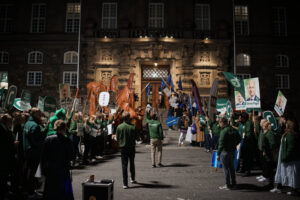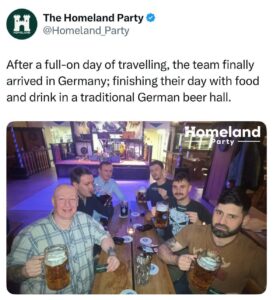This article is part 6 of 7 in the Hammerskins Series. This series was originally published in German via Exif – Recherche & Analyse, and gives us an in-depth look into one of the oldest and most stable neo-Nazi organisations worldwide. The sixth part of the series delves into the transnational aspect of the organisation and associated problems they face because of it.
Part 1 of this series draws a larger picture of the network, its history, and its organisational infrastructure. Part 2 explains the identity of Hammerskins and its members, their rules and codes, as well as symbols and visuals they deploy. Part 3 gives a detailed account and explanation of their engagement in criminal activities, such as murder and terror attacks. All their activities are funded via multiple streams of revenue, which Part 4 analyses. Part 5 sheds light on the role of Hammerskins in the ‘NSU Complex’. The final part of the series, Part 7, focuses on the failure of German intelligence services to identify Hammerskins as an influential actor within right-wing extremism in Germany and worldwide. One central goal of this series is to drag Hammerskins workings out of the shadows and give possibility to the developing of counter-strategies, which so far seemingly has not happened.
Meetings on transnational (problem)coordination
International meetings are the cornerstone of aligning the brotherhood and enabling it to respond across borders should local chapters be experiencing difficulties. Regular meetings are also needed for the frictionless coordination of the brotherhood’s worldwide operations.
A nationwide meeting, referred to as the “National Officers Meeting” (NOM), takes place every two to three months, alternately organised by the respective regionally responsible chapter. In Germany, between 50 and 70 people attend these gatherings.
A meeting at the European level—which, generally speaking, is usually attended by just as many people—is referred to as a “European Officers Meeting” (EOM). It takes place up to four times a year over an entire weekend. The respective country is also responsible for hosting the gathering and taking care of the corresponding logistics. Both the EOMs and NOMs are attended not only by the “officers”, as the name of the meeting might suggest, but also by members without any specific role. “Prospects” have to leave the meeting during certain sections of the agenda. At the EOMs and NOMs, however, there are extra meetings which are exclusively attended by the “officers”.
Regardless of whether at a NOM, EOM, “Sommercamp” or “Wintercamp”: the discussions held there are highly confidential, and important decisions can be discussed face to face.
Portugal: weapons, drugs & “Hells Angels”
In 2006, the Portuguese intelligence service SIRP sent a report to the Federal Office for the Protection of the Constitution (or Verfassungsschutz, the German domestic intelligence service comprising separate national and regional bodies) in Cologne in which it disclosed that, according to its information, Thomas Gerlach was responsible for arms shipments to the “Portugal Hammerskins” (PHS).
Of particular interest were silencers included in these shipments, which Gerlach had supposedly attempted to obtain via the neo-Nazi Alexander Larrass (now Rotelli) in Switzerland. There are close ties between Gerlach and the Portuguese Hammerskins.
In 2006, when the neo-Nazi “Fest der Völker” [Festival of Nations] was supposed to be held in Jena, the head of the PHS at the time, Mário Machado, was scheduled as a speaker. Gerlach had a leading role in organising the “Fest der Völker”—alongside the NSU supporter Ralf Wohlleben, among others. Machado had already served a prison sentence, after—motivated by his racist worldview—he beat up the 27-year-old Alcindo Monteiro on the streets of Lisbon so severely that he died.
Shortly before the “Fest der Völker” in 2006, Machado was arrested in Portugalonce again, but upon his release planned to travel to Jena with 30 other neo-Nazis from the “Frente Nacional” [the Portuguese National Front] and a group of French Hammerskins. Thomas Gerlach would pick them up at the French/German border.
The “Fest der Völker” did not take place, but, in 2006, Machado and his “Portugal Hammerskins” were entertained by Gerlach and the “Hammerskins Sachsen” [Saxony Hammerskins], among other things, with a Ritteressen [knight’s banquet] at the Leuchtenburg Castle in Jena. Ralf Wohlleben was part of the circle.
In 2007, another raid by the Portuguese police terrorism defense unit on the PHS and Mário Machado took place. 27 people were charged for the possession of illegal weapons and kidnapping, among other things—fourteen of them belonged to the “Portugal” chapter.
A few days after the raid, a conference of the European far-right took place in Lisbon, Portugal, at which Thomas Gerlach was also billed as a speaker. Eight days after the conference, German Hammerskins held a “National Officers Meeting” (NOM). According to the report by an attendee of the meeting who, incidentally, was working as an informant for the intelligence service at that time, people exchanged views about the events in Portugal and other affairs.
The Portuguese authorities had imposed contact bans on the Hammerskins. As the discussion at the NOM confirmed, the attendees deemed it perfectly valid to ‘subvert’ these bans. It was decided that “ACE” (Gerlach’s alias) should take care of this.
In 2016, further raids on members of the PHS followed. Approximately 20 members of the chapter were investigated on the grounds of suspected hate crimes and attacks on 20 people as well as an attempted murder. During his imprisonment, Machado obviously lost control of his chapter—the trafficking of cocaine and heroin evidently became a problem. The conflicts and machinations among the Portuguese repeatedly ended up on the agenda of the European “Hammerskin Nation”. And the problems between “Hells Angels MC” and the PHS also had to be addressed.
After these rumours had emerged, the Hammerskins arranged a meal with leading figures from the local “Hells Angels MC” chapter. ‘We have no issues with them (…), but we don’t want to hear any more shit and bad words about it. So, we won the “war” against them, the “war” which they started.’ Being at “war” with the “Hells Angels MC” means starting an argument with organised crime. It is surprising that the Hammerskins considered themselves to be the winners of this conflict.
The internal dispute in Portugal also appears to have been resolved and a lively exchange is taking place between the “Portugal Hammerskins” and their “brothers” in other chapters.
Expansion to South America
It was also the “Portugal Hammerskins” who supported neo-Nazis from Brazil in setting themselves up as “Crew 38” around 2016. In the autumn 2020, they received the official permission to refer to themselves as the chapter of “Hammerskins Brazil” henceforth.
Prominent individuals from the scene belong to the chapter today. For instance, Alexandro Carneiro, the singer with the popular right-wing rock band “Zurzir”, who lives in the US and plays in a band called “38 Warmachine” today. Carneiro had already visited German (and other European) Hammerskins and presented himself in “Crew 38 Rheinland” [“Crew 38 Rhineland”] T-shirts in 2016.
Miguel D’Almada is no stranger either. He is originally from Portugal but moved to Brazil in 2017. He rose to fame as the leading member of the “Juve Leo” fan club of the football club Sporting Lisbon. He was involved in the manufacture and sales of the club’s official fan merchandise, but is said to have fallen out with his business partners due to disagreements over the amount of profit earned. According to insiders from the Sporting Lisbon fan scene, this is what prompted his move to Brazil. There, he drew public attention again in 2017 after having posted several videos on YouTube in the name of the fan group “Rapaziada1906”.
What made his clips so controversial was that fact that he shared private addresses and contact details of referees and commentators linked to the football club Benfica (Lisbon) in some form or another. D’Almada attended the “Hammerfest” in France in November 2019, clad in “prospect” merchandise.
About a year earlier, his fellow campaigner, the Brazilian national and “prospect” Laureano Vieira Toscani, stood trial in Porto Alegre. He was part of a group of neo-Nazis who, on 8th May 2005—the 60th anniversary of the end of the war—had beaten up and attacked a group of Jewish people in a bar with knives. One of the victims was taken to the intensive care unit with serious injuries. Toscani was sentenced to 13 years in prison.
Meanwhile, memes circulated on the web by Hammerskins state “Free Laureano”. João Guilherme Correa, by contrast, who is a “full member” of the Brazil chapter today, has never been held accountable for his role in a murder some years back. Specifically, he was involved in the murder of a couple in the region around Curitiba on the night of 20th April 2009. The couple themselves belonged to the neo-Nazi scene and had in fact been commemorating the birthday of Adolf Hitler together with their eventual murderers earlier that same evening. It appears that the couple, in particular Bernardo Pedroso, did not agree with their radicalism.
Pedroso, who was considered an influential intellectual in Curitiba, is supposed to have spoken out against attacks on homosexuals. He and his partner were later lured into an ambush and then shot in the head and killed. The three neo-Nazis, among them João Guilherme Correa, were released after only a brief period of imprisonment and have not been convicted for the crime to this very day.
Instead, he joined the Hammerskins and, in November 2018, went on an introductory visit to Germany, besides other countries. Pictures which emerged at the time show him, for instance, wearing a “prospect” patch in front of Joseph Goebbels’ villa in Wandlitz in the state of Brandenburg.







